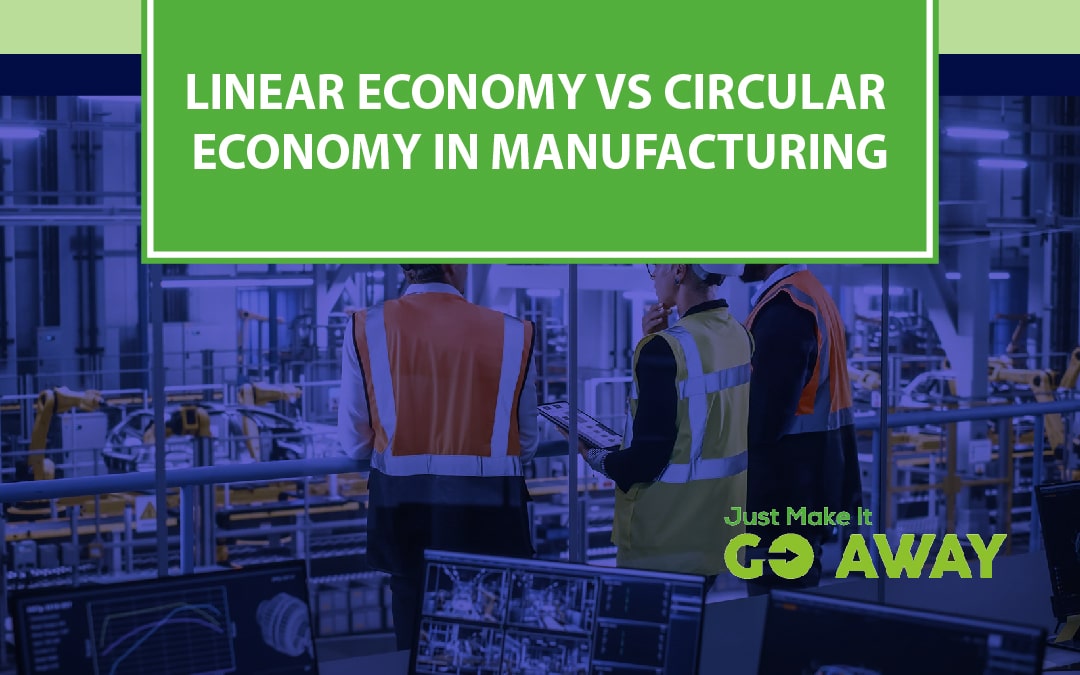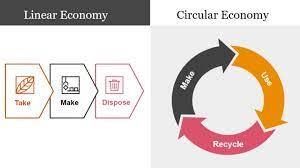Globally, the manufacturing industry is massive. In the United States alone, it accounts for around 11% of total economic output; in 2020, this was around $2.3 trillion to the U.S. GDP. A smoothly working industrial sector is integral to a high-functioning global economy. However, strains on the global supply chain, depleting resources, and encroaching climate change are all forcing us to reshape how we think about manufacturing. Let’s dive deeper as we look into linear economy vs circular economy in manufacturing.
While most manufacturers think only about the process of creation of a product, taking into account what happens after getting the product to market is just as important. Many manufacturers think in terms of a linear economic model, but thinking about product circularity can open up more efficient input, processing, and output methods.
Linear Economy Model
Historically, global manufacturing systems have relied on a linear economy. This economic model relies on the extraction of raw resources, processing them into final products, and distributing them throughout the world. Those products are then typically purchased, used, and disposed of by consumers. This has created a continuous cycle of customers buying and then throwing away products.
The focus of this linear journey from extraction to disposal is on maximizing profit. This is done by minimizing costs as much as possible and relying on consumers to repeatedly buy products that will eventually be disposed of. Over time, this has put a strain on the countries contributing raw resources and manual labor to produce goods. It has also contributed to massive amounts of waste along all parts of the manufacturing process.
In recent years, this system has come under more scrutiny. The demand for manufactured goods continues to rise while resources are becoming more scarce and the effects of pollution on our climate have become more apparent. In the linear economy, steps can be taken to minimize waste and reduce the negative impact on the environment through green manufacturing. Since the model relies on the disposable nature of goods, however, those efforts, though helpful, will still contribute to the strain on our resources.
Circular Economy Model
Countries and manufacturers have begun to value new processes that minimize waste and extend product life cycles in a new model called the circular economy. In this economic model, value is created by keeping resources out of landfills and instead circulating them back into the manufacturing process.
Another tenant of the circular economy is regenerating nature. In contrast to the extractive nature of the linear economy, the circular economy works to rebuild natural capital and increase biodiversity. For example, this could be through reducing the amount of land used in mining or reducing the carbon footprint of production.
To fully transition to the circular economy, there must be an ideological shift from both manufacturers and consumers to rethink the lifecycle of the goods we purchase. In a fully realized circular economy, the manufacturing industry would no longer rely on scarce resources. Manufacturing processes would not just minimize negative impacts but would actually have positive ones on the economy and environment.
Steps can be taken throughout the manufacturing process to move towards a circular economy in all three of the main facets of manufacturing:
-
Input
To put it simply, waste can become the new raw material. Through recycling and upcycling, waste that would previously be disposed of, it can be given a new life. By manufacturing with material waste, dependence on quickly depleting resources is diverted.
In all industries, supply chain audits can help companies evaluate where raw materials are coming from. Research can be done to find new alternatives to finite resources like fossil fuels. Using alternative inputs can reduce the dependence on scarce resources which will save money over time as scarce resources will continue to rise in price.
-
Process
Manufacturing is an energy-intensive process, responsible for around 33% of total energy consumption. Investing in energy-efficient equipment can reduce this consumption while also saving manufacturers money over time.
Most manufacturing is done through either subtractive or additive manufacturing techniques. While subtractive manufacturing inherently generates waste, a combination of both techniques can be used to efficiently produce products with as little waste as possible. The waste that is generated can either be recycled or sold to companies like Just Make It Go Away who work to find other ways in which the waste can be used.
-
Output
The manufacturing industry can make one important change by making higher quality goods with longer life cycles that are not meant to be quickly disposed of after use. Consumers can then reduce the number of new products they purchase and reuse the ones they currently have. Items that are eventually disposed of after use can either be recycled or upcycled to divert them from landfills.
Taking The First Step
One of the first ways you can contribute to the circular economy is by changing your mindset on manufacturing from thinking within a linear economic model. Prioritize sustainable manufacturing practices by making thoughtful choices during the input, process, and output phases of manufacturing. Want to learn more about reverse logistic services that can contribute to a more circular company?
To learn more about making the circular economy a reality, check out the Ellen Macarthur Foundation which works to accelerate the transition. The Foundation supports organizations and individuals with education on the circular economy with the mission of making widespread changes in how people view the economic systems they engage in. How will you work to change your company’s mindset? Do you now understand the difference between linear economy vs circular economy?


